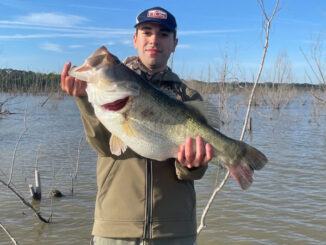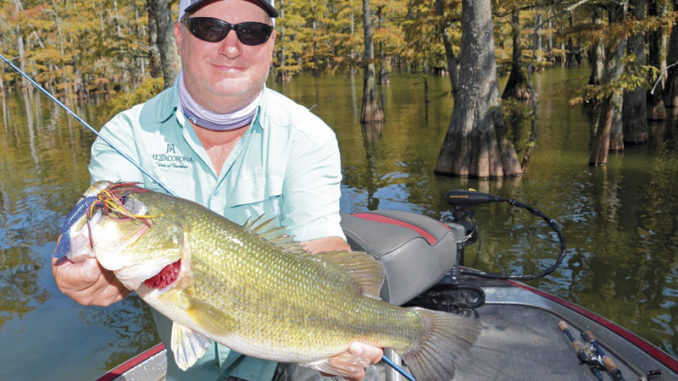
Ancient tree systems create a labyrinth of cover for largemouth bass
The official state tree of Louisiana, bald cypress, line nearly every lowland river along the Gulf Coast and grow in many lakes. Some reservoirs more resemble flooded swamps than impoundments.
These massive trees provide excellent bass cover all year long and especially this time of the year.
“If I only had one cover to fish for the rest of my life, it would be cypress trees,” said Greg Hackney, a bass pro from Gonzales. “On a good tree, I can often catch more fish in the first hour of the morning than I can the rest of the day. The biggest bag of fish I ever caught in Louisiana came out of Lake Henderson, which is full of cypress trees. My best five weighed more than 30 pounds, but I caught a lot more than that.”
Since the ancient trees impervious to rot can grow in standing water, these giants provide abundant living cover from surface to bottom. Live trees continue to grow and make new cover that attracts a host of species, creating entire ecosystems above and below the waterline. In contrast, dead or dying timber decays, eventually leaving little to interest bass or other species.
“Cypress trees are great places for bass because they provide them with so much cover,” said Brian J. Heimann, a Louisiana Department of Wildlife and Fisheries biologist. “To a bass, a cypress tree is essentially a big reef. It’s not just a plain tree trunk coming out of the water. It has lots of stuff underneath the water that provide cover for fish and all other kinds of small animals.”
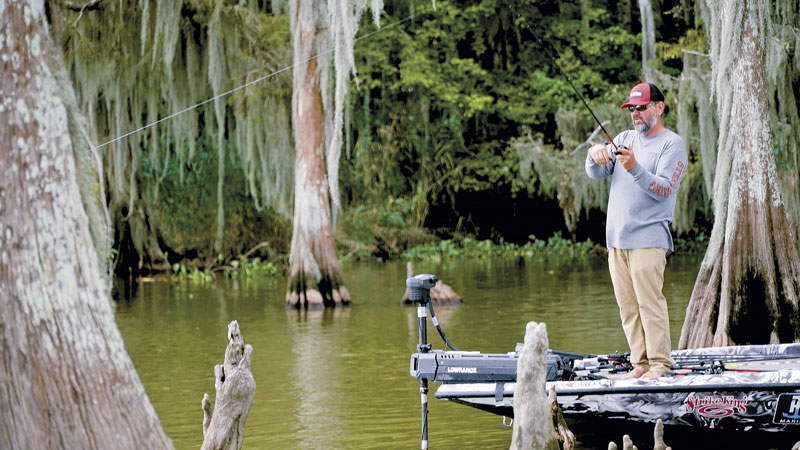
More than the tree
Standing like soldiers protecting a fort, hard “knees” protrude above the ground surrounding many trees. Knees help trees breathe in water or soggy soil. Besides knees, root shoots split directly from the trunk to create a “root ball,” a feature unique to cypress. Below the waterline, but above the bottom, root balls spread out to help anchor the big trees in the muck.
“Cypress trees can provide bass with abundant cover, much more than just a tree trunk or a stump,” said Dennis Tietje, a retired professional bass angler now working for Grosse Savanne Lodge (www.grossesavanne.com) in Lake Charles. During low water, the bottom of some trees looks like an octopus with all the things coming off them.”
Algae and other small organisms grow on the trees, feeding insects, crustaceans and various other invertebrates. Small fish find refuge among submerged nooks and crannies. Little creatures attract larger predators like bass. In addition, lizards, snakes, birds and other small animals dwell above the water, but occasionally enter it. They provide more food for lurking lunkers. In addition, doughnut-shaped grass rings often grow around cypress trees standing in deeper water.
Trees can hold fish all year long, but anglers frequently find the best action in the spring. Many cypress trees grow well off the shorelines, creating protected pockets behind them. Trees serve as barriers to protect those shallows from wave action. Many bass spawn in these placid, shallow pockets.
On a long river shoreline or a lake filled with cypress trees, not every tree produces good bass action. Some only hold bass in the spring or at other times. Anglers need to determine patterns through experimentation and observation. Then, they can bypass many unproductive places.
“In a river with miles of shoreline lined by cypress trees, everything looks pretty,” Tietje said. “It can be mind-boggling because each one should hold big bass, but they are not all alike. I like to fish isolated trees or ones that extend farther off the shoreline and form a visible point or a harder current break. I tend to stay away from ones too heavily surrounded by knees. When I catch good bass, they are usually not around the knees, but right up against the trunks. After learning how to read the trees, people can go down a shoreline and pick out ones that should hold fish.”
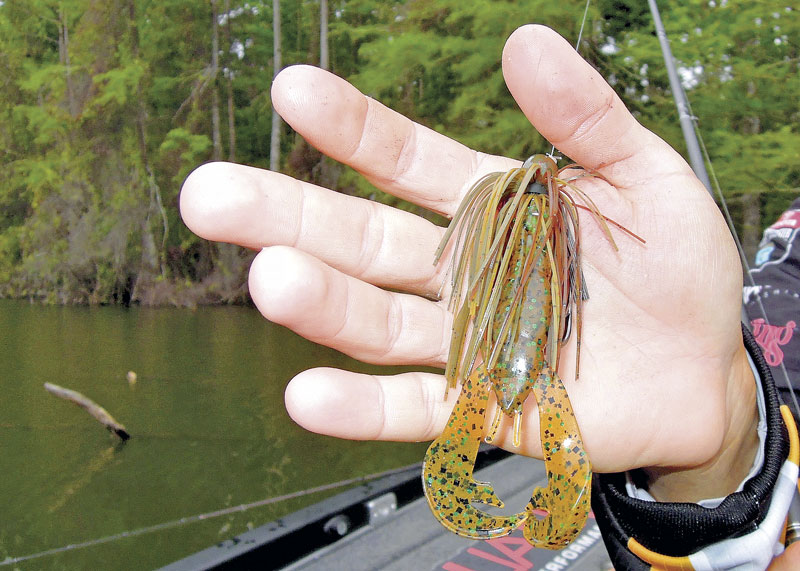
Cover territory quickly
Sportsmen need to search for fish to determine patterns. When searching for bass, throw baits that cover extensive territory quickly. These include crankbaits, buzzbaits, spinnerbaits, bladed jigs and swimming jigs.
“When searching for bass, I like to swim a Strike King Hack Attack Heavy Cover jig,” Hackney said. “When water warms up, I work a swim jig pretty fast and erratically near the surface, so fish think food is getting away from them. I’ll put on a Strike King Rage Craw trailer because I want something disturbing a lot of water. For colors in South Louisiana, it’s hard to beat a black and blue jig with a black and blue fleck Rage Craw. In clearer water, I’ll throw a bluegill-colored swim jig with a Candy Craw trailer. A Strike King Tour Grade buzzbait with a Strike King KVD Buzz Toad trailer is another good bait to throw around cypress trees in the spring.”
In an impoundment, a lone tree or a small cluster could mark a hump where water depths vary. Isolated trees frequently attract big bass. Be sure to fish completely around any isolated cover whenever possible. Rows of parallel trees could indicate an old creek channel or ditch. Bass regularly use underwater channels to get in and out of spawning areas.
“In March and into April, it’s all about getting into flatter water and pockets,” said Paul Elias, a former Bassmaster Classic champion from Laurel, Miss. “Little feeder ditches that lead to spawning flats are great places to fish. Many times, cypress trees grow right on the lip of the ditch. Those places are great to fish in the spring.”
Standing out
In late winter or early spring, bass in cold water don’t want to chase anything too fast or too far. Bedding bass guarding fry or eggs, however, turn very aggressive and chase potential predators away from their domain. While not actively feeding, bass might react to something passing over their bed. Even if a fish doesn’t strike, it could reveal its location, giving anglers a second chance at it.
“One of the keys to fishing cypress trees is to find one that stands out,” Elias said. “My number one method in the spring is to throw a 3/8-ounce ChatterBait in black and blue or red and black. I work it with a medium retrieve. A ChatterBait skips well so anglers can skip it under low branches to get into places where others can’t go. I also like to throw a 3/8-ounce Mann’s Classic spinnerbait in chartreuse and white, but a ChatterBait usually gets more bites because it’s a newer bait.”
After finding good fish, thoroughly work over the area with slower, more subtle enticements like jigs tipped with creature baits, Texas-rigged worms or flukes. These lures make excellent follow-up baits. Throw one immediately after a fish swirls or moves, but doesn’t take the search bait.
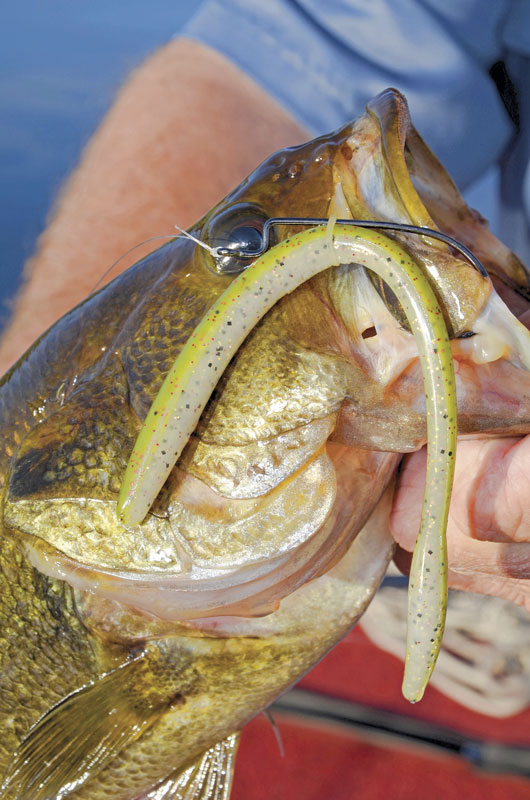
“I often use a green pumpkin or watermelon red magnum fluke with an 1/8-ounce pegged weight around cypress trees,” Elias said. “I’ll skip it under the limbs by the trunk. Usually, fish hit it right away, but if not, I work it very slowly and let it sink. I’ll twitch it a little. A wacky worm can work around the cypress trees if it has a good weedless hook. Spawning bass see that bait slowly sinking toward them and react.”
In late winter or early spring, crawfish emerge from the mud and crawl around the lower trunks, root balls or knees. Crawfish provide bass with a major protein source, but they also notoriously raid bass nests. Therefore, lures that mimic crawfish commonly provoke vicious strikes.
Nothing imitates a crawfish like a jig sweetened with a craw trailer. Weedless jigs can slip through entanglements better than most lures. Drop jigs as close as possible to tree trunks or other cover and drag them out slowly.
“My number one lure for fishing around cypress trees is a jig,” Hackney said. “A jig does a good job replicating a crawfish and generally catches bigger than average bass when fished around cypress trees. Once water starts warming up, I like to throw a frog around cypress trees because bass suspend around them.”
Moving into April, post-spawn bass turn their attention away from reproduction to replacing their energy reserves depleted during the spawning process. That makes them attack baitfish and anything else more aggressively. Some fish stay around cypress trees all year long, but many move out toward deeper water.
“During the post spawn, a flipping jig gets really good,” Hackney said. “Just after bass finish spawning, they want to find something big and slow. I use a ½-ounce Strike King Hack Attack Heavy Cover flipping jig tipped with a black and blue Rage Craw. Texas Craw is another good color for the jig with a black neon craw as the trailer. I also like a solid blue trailer when fishing on cloudy days.”
All year long, cypress trees can provide good bass action. In many areas of Louisiana and Mississippi, nature doesn’t give anglers very many other choices, so learn to fish the ancient giants during all seasons.
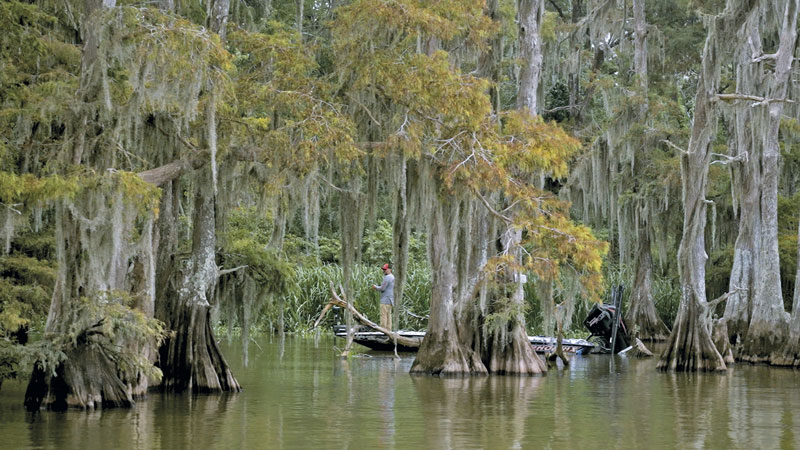
Amazing ancient cypress trees are legendary
Loggers sawed through most of the virgin bald cypress swamps across the South in the late 19th and early 20th centuries, but they didn’t get all of them. Many ancient wind-twisted trunks unfit for lumber still dot Southern swamps and some vestiges of the original forests remain.
Estimated to be more than 1,500 years old, the National Champion Bald Cypress grows on Cat Island National Wildlife Refuge near St. Francisville. Not the tallest at 96 feet high, it measures 56 feet in circumference.
Once one of the tallest and oldest trees in the United States, a cypress near Sanford, Fla., reached 165 feet tall before a hurricane knocked 40 feet off the top in 1925. It had a circumference of 47 feet and lived approximately 3,500 years before vandals burned it down in 2012.
The current tallest living tree grows near Williamsburg, Va., and reached 145 feet tall.
A tree living near High Springs, Fla., is estimated to be more than 2,700 years old. A tree growing along the Black River in North Carolina is about 2,620 years old.
